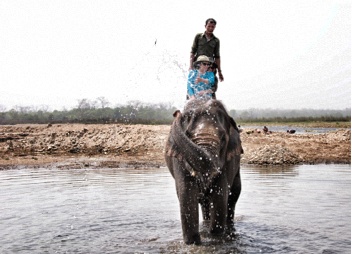by Jane Spencer
“Guess what? I rode an elephant in Nepal!”
 My five-year-old grandson was not impressed. “You rode one of those dirty, smelly things?” He’s very sensitive to unfamiliar odours and textures.
My five-year-old grandson was not impressed. “You rode one of those dirty, smelly things?” He’s very sensitive to unfamiliar odours and textures.
“Well, we gave her a bath,” I elaborated, over the phone.
Weeks later, I was still thrilled with my visit to Chitwan National Park in Nepal. The park, located in the terai or subtropical lowlands of the country, is a UNESCO World Heritage Site with a diversity of ecosystems (forests, ox-bow lakes and flood plains), animals (rhinos, sloth bears, deer, crocodiles), and birds (hornbill, kingfishers and peacocks). Elephant numbers there have grown to fifty. They live in a protected environment in exchange for safari labour, with a guarantee they won’t be transported to zoos or hunted for ivory.
It was my first safari and my first contact with elephants. Our group of four was guided to a platform with stairs which we took turns mounting, before lowering ourselves into a box frame roped around the elephant’s girth. The elephant trainer, or mahout, wielded his sharp metal hook and shouted an order, then we were off into the grasslands to search for one-horned rhinos, and maybe, if we were lucky, a Bengal tiger.